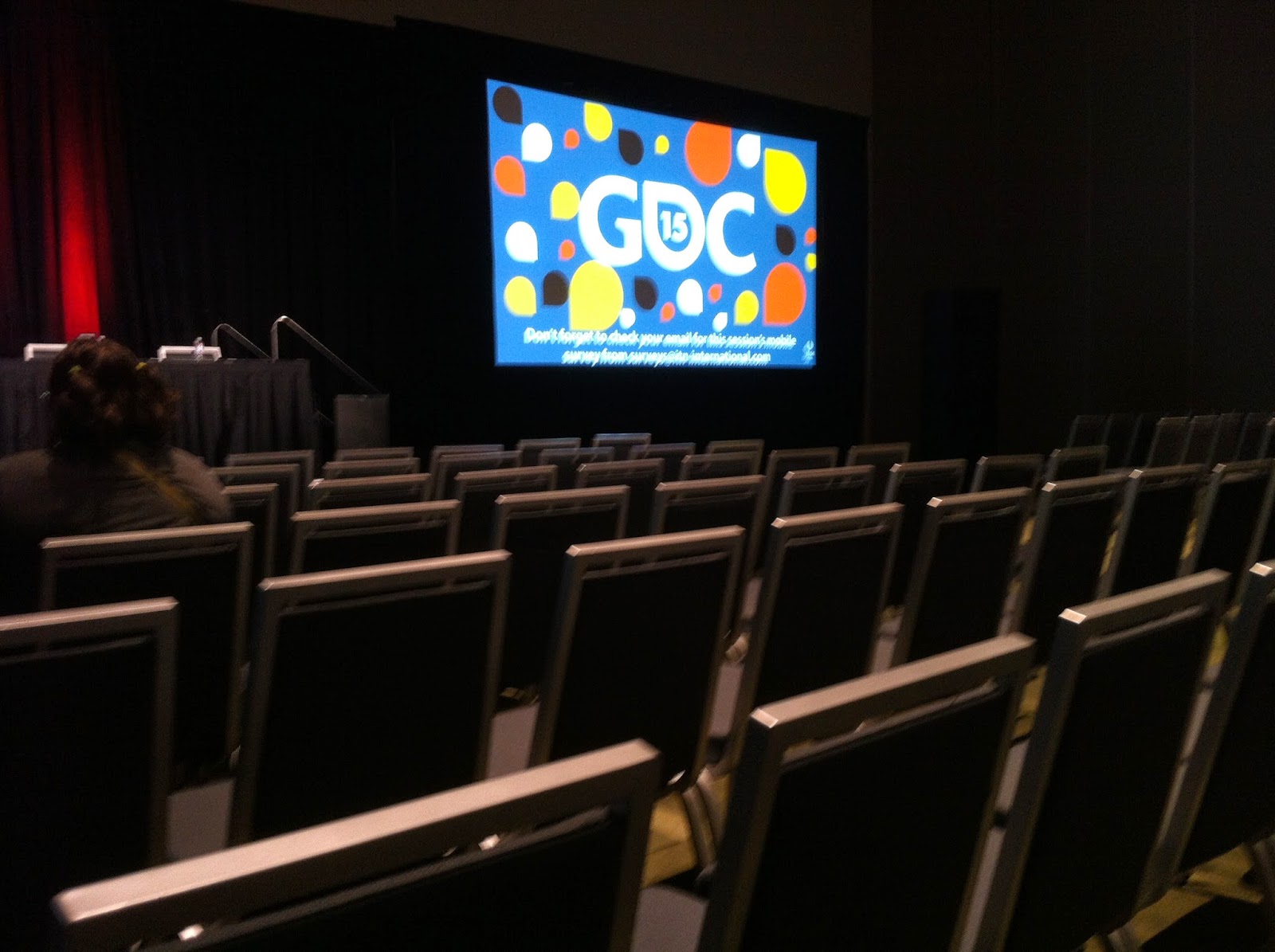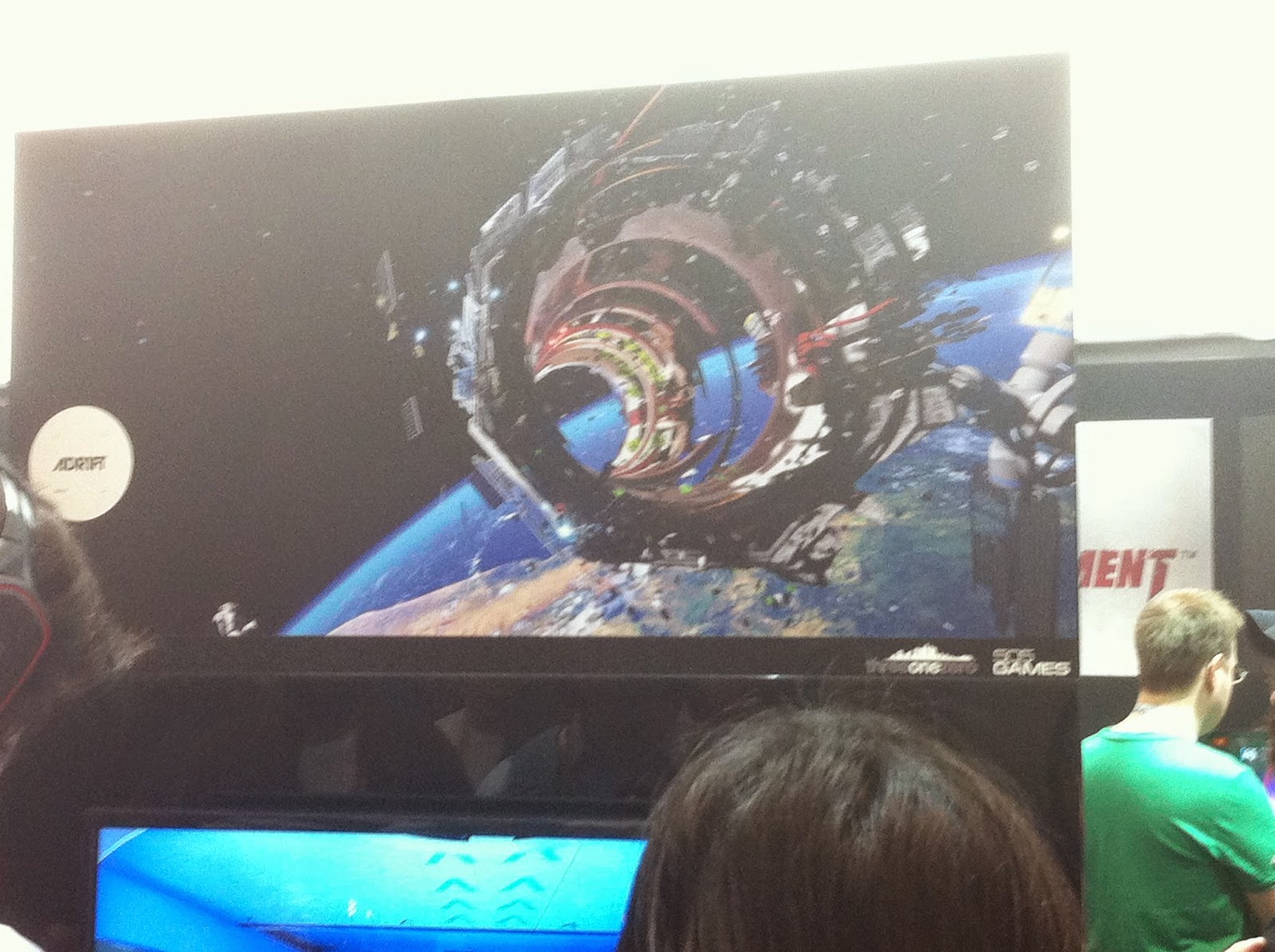Game Developers Conference 2015: A
Reflection (& Pictures!)
Special Feature
Abstract: GDC 2015 is a meeting filled with
vibrant new ideas, excited game developers, and a well-honed focus on the games
industry: whether it is getting your start, refining your work, or a glimpse
into the future of video games. As the first video game conference I have ever
attended, I was overwhelmed with the scale of the event and the talent of those
present, both exhibitors and attendees. The show floor was filled with great
games and experiences. I used my one-day student pass predominantly to get a
glimpse into what it takes to break into the games industry. I left feeling a
fuller appreciation of the current duality of beginning your career in video
games. One on hand, increasingly rigorous academic training is creating a new
generation of highly skilled game artists, designers and programmers well
qualified for work following graduation from college. On the other, the
widespread availability of game making tools and collaborative game making
projects (game jams) gives those without formal training an avenue to break into
the industry. For someone like myself, I have a long way to go if I ever hope
to work in video games, but at least the path to doing so is clearer now than
it has ever been.
I have
wanted to attend a video game conference for the longest time. I watch events
like the Electronic Entertainment Expo (E3) and Gamescom with a jealous eye,
wishing that I were there to experience the new games in person and speak with
developers. Attending a meaningful conference is easier now than it has ever
been with the advent of Penny Arcade Expos (PAX), where open access to the
public allows anyone to get real face time with developers and industry
veterans. And then you have the Game Developers Conference (GDC). GDC is the
world’s largest and longest running professionals-only game industry event. While
E3, Gamescom, and even PAX to a lesser extent, are marketing heavy trade shows,
GDC is more focused on game makers coming together to share ideas, grow
networks, and present the future of games.
GDC is replete
with informational sessions. In these, lecturers speak about the principles of
production, programming, visual arts, management and more. These talks really reminded me of the scientific meetings I have attended, where speakers share
their findings and help to grow the core knowledge of the community as a whole.
The conference featured two separate show floors. The expo floor features
hands-on kiosks for upcoming games, like other conferences. The emphasis here
is not necessarily on the new games, though, but more so on the new technologies,
services, and innovations that are moving games forward. For instance, this
year’s show floor was filled to the brim with virtual reality (VR) exhibits,
supplemental VR technology (like haptic feedback-based controllers), and new
support services for an increasingly mobile game rich industry. The second show
floor features GDC’s Career Center. GDC itself compiles a list of hiring
companies and the jobs they have available. Indeed, the Career Center expo area
is a self-contained job fair, where publishers, developers and companies alike
are looking for new talent. GDC’s ‘professionals-only’ mindset creates an
intense career-oriented conference dynamic. Attendees carry around copies of
their resume, giving it out to anyone receptive. Business cards are a must, as
nearly every conversation I witnessed resulted in their exchange. And this is
well-understood: people attend GDC to grow their network, gain new friends and
colleagues, learn from their peers, and potentially set up future collaborative
projects or jobs.
To that
extent, I was a very much a fish out of water. As you all (probably) know, I am
a biomedical sciences Ph.D. candidate. I was able to attend GDC through my label as a student,
though perhaps not the kind of student the organizers intended. I attended,
first a foremost, to gain insight into the work I would have to do if I ever
hoped to work in video games. Secondarily to see all the cool new games and
technology on display. Because of this, however, initiating a network for
myself was difficult. Once the attendees (and exhibitors) learned of my current
work as a science Ph.D., many of the conversations quickly died off. I have no
experience in coding a game, creating a design document, or any real games
portfolio to speak of whatsoever. Attendees are mainly looking peers to help
hone skills with, and jobs. Exhibitors are looking for skilled game makers. I
offered none of the above. Still, conversations about games themselves were
great, and many were interested in why I was thinking about working in games. Every
time I was left in awe, too. So many young people have already made a handful
of games, have coded in several game engines, been a part of game jams, and
more. The talent that surrounded me at GDC was astounding, and I loved being a
part of what was (and was not) on display.
It was
clearly “too early” for me to attend GDC for the reasons the majority of people do, early-to-mid stage career development. But that was never my intention. I
wanted to learn about what working in the industry was like and the skills I
would need to gain in order to do so. To that extent, I attended a ton of seminars. To cite a couple:
“A New R&D Process
for Game Design”
“From Student to Designer/Writer”
“Ten Tips for Successful Game Industry Interviews”
“Internships,
Bridging the Gap”
These talks
were great. I will not go into any great detail, but I learned key takeaways about
portfolio creation, what to say and what not to say at an interview, and how to
assess the worth of an internship. Here again, the games industry has so many
parallels with the life sciences. Perhaps the best example was at the talk in
which I learned about “PlayStation University,” a 12-week internship program
that almost point-for-point matched the objectives and design of the two
research science internship programs I participated in prior to my acceptance
into graduate school. It is a great way to hone your skills and understand what
goes into that career, so it was neat to see a big name in games adopting this
successful model. I was happy I attended the sessions I did, because it allowed
me to refine my understanding of working in video games. I enabled me clearer
tools self-assessment, perhaps even brutally so, while simultaneously giving me
a clearer picture of what work lies ahead of me should I chose to pursue that
path. Like all career exploration, I was first met with a huge wave of anxiety
that, following synthesis and reflection, became more manageable. Ultimately, I
need to focus on narrowing down potential careers to pursue, and get experience
via game jams and independent projects.
One quick
aside, and key takeaway, is the emerging duality in game makers. I had known
about this for a while, but it was educational getting to see it at its beating
heart. The landscape of academic training for games is rapidly growing.
Programs now span the country, even at top tier schools like the University of
Chicago, that focus on game design and game-specific coding & programming.
This is creating highly trained, highly skilled students with rich portfolios
derived from a combination of class projects and game jams with friends. When
looking at games from this perspective, it is going to be increasingly hard for
non-trained individuals to find a job in video game creation—the pool is just
that much more competitive. On the polar opposite side of the spectrum is this
new age of self-taught, fully independent game makers. Great game creation
tools now exist for anyone to download, like Stencyl and GameMaker. Following
the huge announcements at GDC, Unreal, Unity, and Source 2 engines are all free
to people to use as well. Great written and video tutorials exist for many of
these engines, allowing nearly anyone with passion and time to create games.
Again, this makes getting hired by a company or studio even harder, since the
pool of applicants is larger now than it ever has been. This duality has made
for an innovative, and interesting, past decade for games, and will continue to
have substantial impacts on the industry for years (perhaps decades) to come.
The main
expo floor allowed me to put all those thoughts aside and just be surrounded by
fantastic new games and experiences. I spent time in the Xbox area playing Gigantic, and at PlayStation’s playing Axiom Verge, Titan Souls, Amplitude and Guns
Up. I got to check out the Independent Game Festival (IGF) pavilion that
had on display a great selection of lauded indie games. There, I was able to
play some Killer Queen, Invisible, Inc., and This War of Mine. There was also this
fantastic section of the show floor called alt.ctrl.GDC that featured
innovative new experiences in gaming. I was able to get hands on with the
unexpected darling of GDC, Butt Sniffin
Pugs, and another game in which you use vibrating controllers in a
battlebot-like arena. Hands-on experiences with virtual reality were either by
appointment only or several hour long waiting lines, so I was not able to try
out Project Morpheus, Oculus Rift, or Vive. Still, VR demos were everywhere and it was interesting to see
people trying them out. Everything I saw and played was a blast, and made me
even more excited about the future of games.
And that’s it for the meatier side of my reflection. I have put a bunch of my pictures from the event below for you all to enjoy! I look forward to attending more video game conferences in the future. GDC was a great learning experience and was a joy to attend. Maybe next time I attend I’ll have more to bring to the table!
 |
| My early morning walk towards the convention center! |
 |
| GDC had this great video game history museum. I didn't get to play, but it was fun to walk around and see the memorabilia and classic arcade cabinets. |
 |
| So early the main expo floor was not even open. Gave me some time for pictures! |
 |
| Waiting for my first talk of the morning. It explored a new direction for the R&D process in game design. |
 |
| The XBox area has a lot of gaming setups. I didn't get a closer picture, but I was able to get my hands on Gigantic, the new MOBA-like gaming coming to Xbox One & Windows 10. I enjoyed what I played! |
 |
| My first look at the PlayStation area! |
 |
| There was this neat patterning in the back of the PlayStation exhibition. I grew up with Sony consoles, so seeing this definitely triggered my inner fandom. |
 |
| Been excited about Axiom Verge for some time. Getting hands on confirmed for me that I will definitely be picking up this neat Metroidvania on 3/31. |
 |
| Amplitude is a remake of the cult PS2 hit of the same name. The rhythm based gameplay worked well and looked beautiful. |
 |
| VR was huge at GDC. Here is the entrance to Facebook/Oculus's display area. |
 |
| Lines to get in were insane, but here is a eerie picture looking into the display Demoers are strapped into the Rift and Gear VR. Gives me strange Sci-Fi vibes! |
 |
| Star Wars VR demo. The participant held a stick-shaped accessory in each hand. The game played out like Luke in the original trilogy, blocking laser shots from a floating drone. |
 |
| Conference over! I got to see a ton of things at my first GDC, and learned even more. |














No comments:
Post a Comment